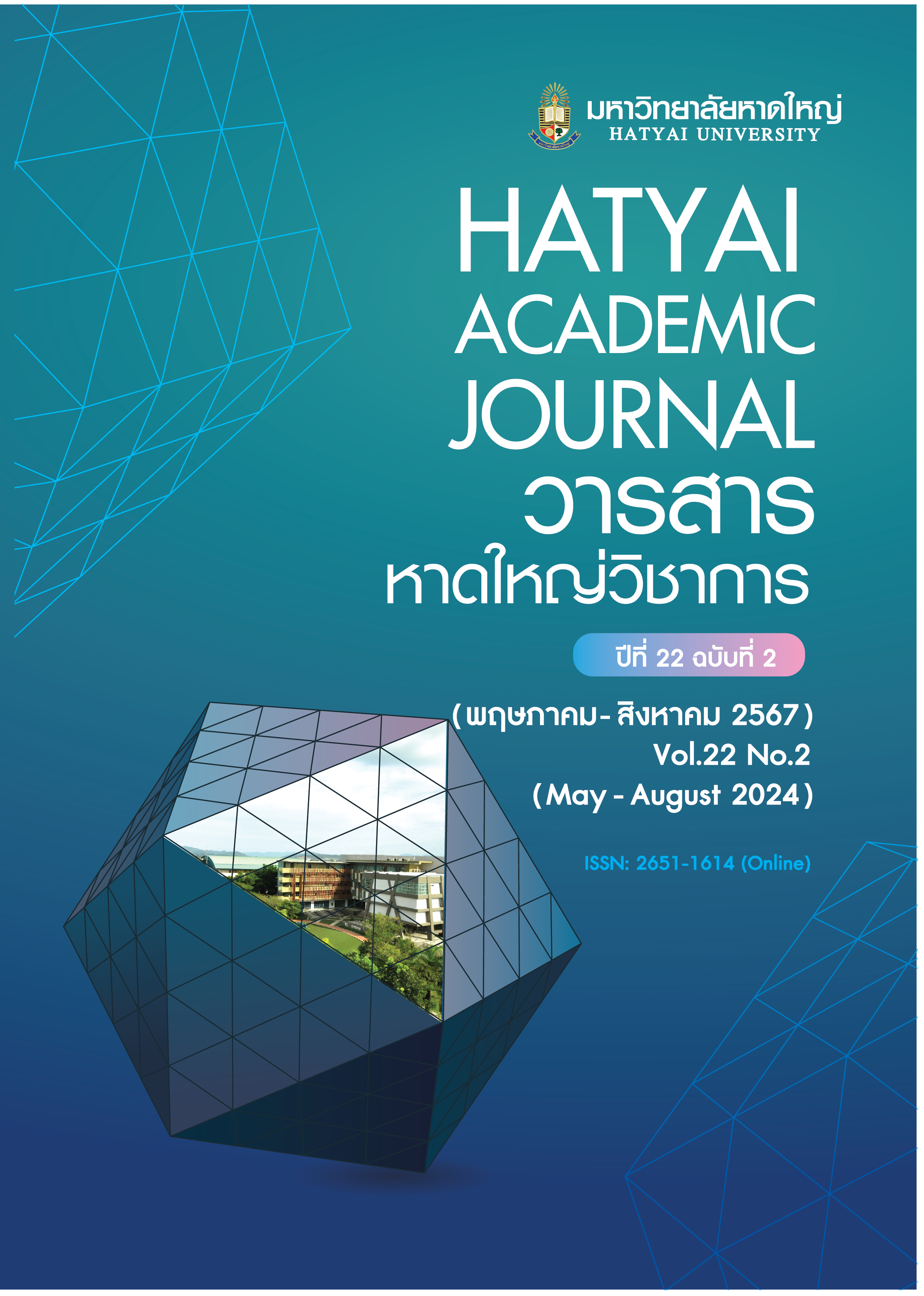A Causal Relationship Model of Digital Citizenship Behavior among Undergraduate Rajabhat University Students
Main Article Content
Abstract
This research aimed to study Rajabhat undergraduate students’ digital citizenship behavior concerning the causal relationship model. This was in the form of quantitative research. The sample contained 847 undergraduate students from Rajabhat universities. The research instrument was a questionnaire on factors affecting digital citizenship behavior with the reliability value between 0.87-0.97. Descriptive statistics were employed to study information of the samples. Inference statistics were used to analyze the causal relationship by analyzing the structural equation model. The research findings revealed that the causal relationship model of digital citizenship behavior was matched with the empirical data ( = 163.22, df = 137,
/df = 1.19, p = 0.063, RMSEA = 0.015, RMR = 0.014, GFI = 0.98, AGFI = 0.96, CFI = 1.00, and NFI = 0.98) as 71 percent of all variables could predict the digital citizenship behavior (R2 = 0.71). Factors which directly influenced digital citizenship behavior were performance expectancy (β = 0.41), effort expectancy (β = 0.25), behavior intention (β = 0.20), and facilitating conditions (β = 0.19). The findings were useful for educational institutions to determine ways for developing digital citizenship behavior of university students.
Article Details

This work is licensed under a Creative Commons Attribution-NonCommercial-NoDerivatives 4.0 International License.
All published articles are evaluated by three qualified peer reviewers from various institutions through a double-blind process, where reviewers do not know the authors’ identities and authors do not know the reviewers’ identities. The content and articles in the Hatyai Academic Journal reflect the authors’ views only and are neither the opinions of the editorial board nor the responsibility of Hatyai University. The Editorial Board of the Hatyai Academic Journal allows articles to be reproduced for academic purposes, on the condition that the original source is clearly cited.
References
Ajzen, I. (2011). The theory of planned behaviour: Reactions and reflections. Psychology & Health, 26(9), 1113-1127. doi:10.1080/08870446.2011.613995
Ajzen, I. (2020). The theory of planned behavior: Frequently asked questions. Human Behavior and Emerging Technologies, 2(4), 314-324.
Alzahrani, A. (2015). Toward digital citizenship: Examining factors affecting participation and involvement in the internet society among higher education students. International Education Studies, 8(12), 203-217.
Choi, M., Glassman, M., & Cristol, D. (2017). What it means to be a citizen in the internet age: Development of a reliable and valid digital citizenship scale. Computers & Education, 107, 100-112.
Curran, M. B. F. X., & Ribble, M. (2017). P–20 model of digital citizenship. New Directions for Student Leadership, 2017(153), 35-46. doi:10.1002/yd.20228
Electronic Transactions Development Agency. (2022). Thailand internet user behavior 2022. Bangkok: Ministry of Digital Economy and Society. [in Thai]
Fishbein, M. (2010). Predicting and changing behavior: The reasoned action approach. New York: Psychology Press.
Goonnasith, P., & Kulophas, D. (2017). A needs analysis for enhancing digital citizenship of students in Matthayom Watnairong School. Online Journal of Education, 12(4), 205-219. [in Thai]
Hair, J., Black, W. C., Babin, B., & Anderson, R. (2010). Multivariate data analysis (7th ed.). Upper Saddle River, NJ: Pearson Educational International.
Jones, L. M., & Mitchell, K. J. (2016). Defining and measuring youth digital citizenship. New Media & Society, 18(9), 2063-2079.
Karduang, K. (2018). Psycho-social factors related to good digital citizenship behavior of high school students under OBEC in Bangkok (Master’s thesis). Srinakharinwirot University, Bangkok. [in Thai]
Ke, D., & Xu, S. (2017, Dec. 7-9). A research on factors affecting college students' digital citizenship. In The 2017 International Conference of Educational Innovation through Technology (EITT) (pp.61-64). doi:10.1109/EITT.2017.23
Kim, M., & Choi, D. (2018). Development of youth digital citizenship scale and implication for educational setting. Journal of Educational Technology & Society, 21(1), 155-171.
Kline, R. B. (2005). Principles and practice of structural equation modeling (2nd ed.). New York: Guilford Press.
Lung, G. N. (2019). Decision-making determinants of students participating in MOOCs: Merging the theory of planned behavior and self-regulated learning model. Computers & Education, 134, 50-62.
Minciu, M., Berar, F. A., & Dobrea, R. C. (2020). New decision systems in the VUCA world. Management & Marketing, 15(2), 236-254.
Naranjo, Z. M., Oliveira, T., Cruz, J. F., Martins, J., Goncalves, R., Branco, F., & Xavier, N. (2019). Examining social capital and individual motivators to explain the adoption of online citizen participation. Future Generation Computer Systems, 92, 302-311.
Office of the National Digital Economy and Society Commission. (2019). National policies and plans on digital development for economy and society (2018 - 2037). Bangkok: Ministry of Digital Economy and Society. [in Thai]
Park, J., & Tan, M. (2016). A policy review: Building digital citizenship in Asia-Pacific through safe, effective and responsible use of ICT. Retrieved from https://unesdoc.unesco.org/ark:/48223/pf0000246813
Pham, Q. T., Dang, N. M., & Nguyen, D. T. (2020). Factors affecting on the digital piracy behavior: An empirical study in Vietnam. Journal of Theoretical and Applied Electronic Commerce Research, 15(2), 122-135. doi:10.4067/S0718-18762020000200108
Phuthorn, D. (2017). Thai digital natives’ awareness of copyright issues related to online manga and amime (Master’s thesis). Chulalongkorn University, Bangkok. [in Thai]
Rastogi, G., Verma, H., & Sushil, R. (2018). Determining factors influencing cloud services adoption in India. Serbian Journal of Management, 13(2), 335-352. doi:10.5937/sjm13-13207
Ribble, M. (2015). Digital citizenship in schools (3rd ed.). Virginia: International Society for Technology in Education.
Schumacker, R. E., & Lomax, R. G. (2010). A beginners guide to structural equation modeling. New York: Routledge.
Tabachnick, B. G., & Fidell, L. S. (2007). Using multivariate statistics (5th ed.). New York: Pearson International.
Venkatesh, V., Morris, M. G., Davis, G. B., & Davis, F. D. (2003). User acceptance of information technology: Toward a unified view. MIS Quarterly, 27(3), 425-478.
Vlaanderen, A., Bevelander, K. E., & Kleemans, M. (2020). Empowering digital citizenship: An anti-cyberbullying intervention to increase children's intentions to intervene on behalf of the victim. Computers in Human Behavior, 112, 106459.

